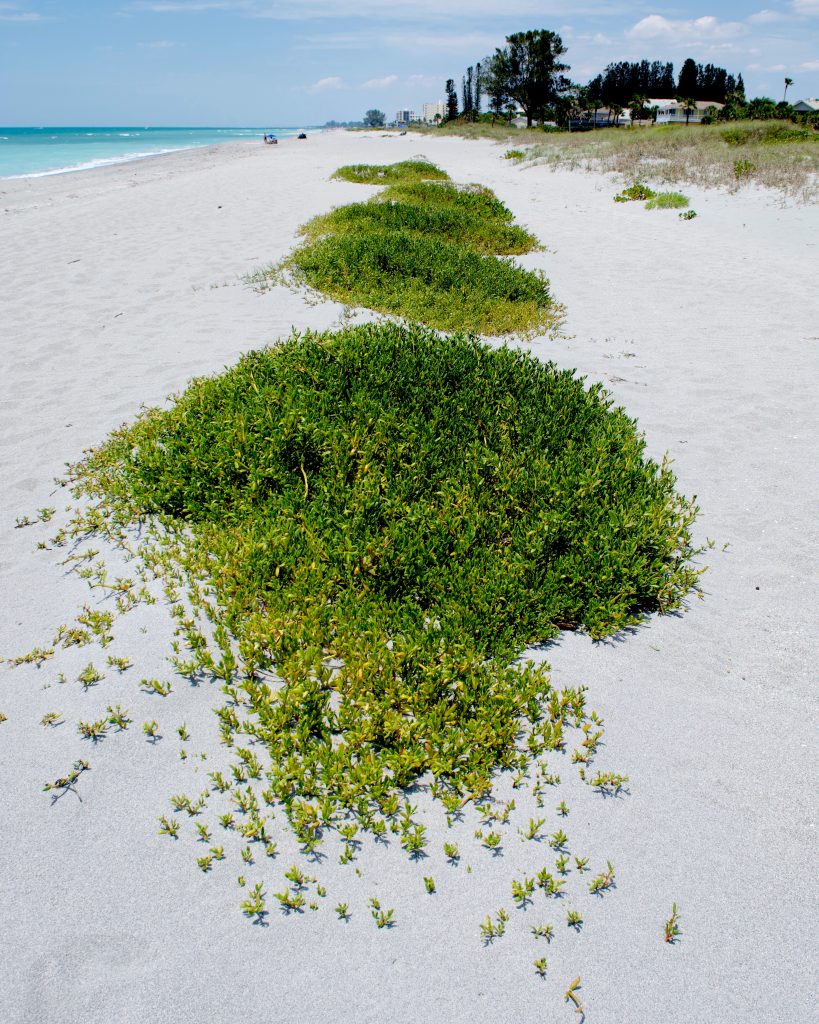
Sea Purslane helping to build Venice Beach by forcing wind to drop sand. Photo by Green Deane
Sea Purslane and Purslane are not the same species, they are not related, and they prefer different environments. But, there is a general resemblance between them; it just depends on how closely you look. Both are edible, look like succulents, grow in a similar pattern, and are close in coloring. But one prefers rich garden soil and the other tolerates salty areas. That said Sea Purslane will grow in your garden it just competes well in briny locations. It is one of those odds oversights that Sea Purslane is not protected like Sea Oats. Like edible Sea Oaks Sea Purslane helps build and maintain beach dunes.
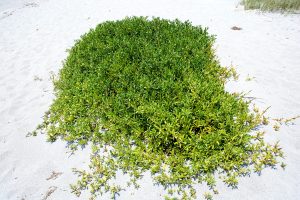
Sea Purslane building its own mound and mini-environment. Photo by Green Deane
On the brackish inland water way you will find Sea Purslane almost anyplace near the water, mixed in with other salt-tolerant vegetation. But on the sea side it is one of the few edibles you will find directly on the beach, year round. Sea Purslane’s niche is that its fleshy leaves causes the sand-carrying wind to slow down. That make the wind drop the sand it was carrying. This makes little dunes and in time little dunes grow into big dunes. The Sea Purslane also keep growing to cover its own dune which helps to keep in moisture and reduce the sand temperature in the summer. In many areas of Asia Sea Purslane is a commercial vegetable. It’s also very easy to propagate. Just stick a stem in moist soil. To read more about Sea Purslane go here.
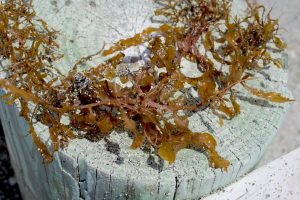
Sometimes even identifying a seaweed species can be tough. Photo by Green Deane
It is said that if a botany professor does not like a particular graduate student an impossible assignment is given: List all of the Hawthorne species. There is no agreement if there are hundreds of Hawthorne species or thousands. Blueberries are not quite as bad but it’s another family that can be difficult to sort out: Are there dozens or hundreds? My candidate for confusion is seaweed. Even with good descriptions each species can vary a lot making identification difficult. This seaweed was seen on Venice Beach after the 16th annual Sharky’s charity bike ride. My first problem is deciding if it is a brown seaweed or a red seaweed. I went with brown but that could be wrong. It seems reasonable to call it a Sargassum and yet there are two forms and many species. Some create a floating mat, the so called free-form. Others attach to something. This was clinging to a bit of seashell. At first I thought “Attached Sargassium” aka Sargassium hystrix. But that bothers me because “hystrix” means “bristly” or “spiny.” I could not see anything on this seaweed that could be called “bristly” or “spiny” yet it looks otherwise about right. The leaves are not toothy, the bladders do not have long stems or a hook on the end like other Sargassums. And it does have irregular dark spots on the leaves. To complicate the matter most S. hystrix have white veins and others do not such as S. hystrix var. buxifolium. I’m definitely in over my seaweed head. Good thing nearly all of them are edible. Perhaps someone will offer a more insightfult identification. To read more about Sargassums go here.
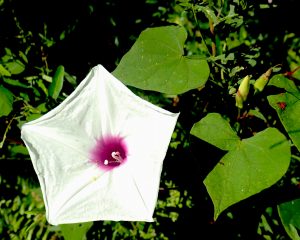
Always investigate Morning Glories that have big white blossoms. Photo by Green Deane
While on the beach I noticed a blossoming Morning Glory. I knew instantly that it would be one I would be interested in. Why? Let me tell you what I tell my foraging classes. After about 40 years of foraging I was organizing my Morning Glory information one day. Some are edible, some are famine food — eaten now and then or in small quantities — and some are mind altering. I did not have a flash of brilliance but one of color. Species of Morning Glories with blue blossoms are usually not edible, often can make you ill while simultaneously getting you high by having the LS part of LSD. Species of Morning Glories with pink blossoms are usually not edible and or are a famine food, kind of 50/50, some edible in small amounts for a while, some not edible at all. They tend to be coastal. And I ignored small white Morning Glory blossom or small white Morning Glories with a ruby throat. However… large white Morning Glory blossoms or large white Morning Glory blossoms with a ruby throat usually have something edible. Large in this case means blossom at least three to four inches long or longer. Which part is edible depends upon the species. You can read about them here.

Foraging classes are held rain, shine, hot or cold. Photo by Nermina Krenata
Foraging Classes: Strictly the east coast of Florida this weekend with a class in Jacksonville on Saturday and then one in Melbourne on Sunday.
Saturday, May 5th, Florida State College, south campus, 11901 Beach Blvd., Jacksonville, 32246. 9 a.m. We will meet at building “D” next to the administration parking lot.
Sunday, May 6th, Wickham Park, 2500 Parkway Drive, Melbourne, FL 32935-2335. Meet at the “dog park” inside the park, 9 a.m.
Saturday, May 12th, Blanchard Park, 10501 Jay Blanchard Trail, Orlando, FL 32817. 9 a.m. Meet at the pavilion east of the tennis courts near the YMCA.
Sunday, May 13th, Bayshore Live Oak Park, Bayshore Drive. Port Charlotte, FL, 9 a.m. Meet at the parking lot across from Ganyard Street.
Saturday May 19th, Eagle Park Lake, 1800 Keene Road, Largo, FL 33771. 9 a.m. Meet at the pavilion near the dog park.
Sunday May, 20th, a non-Green Deane event. Join the Orlando Mushroom Group for its spring fungal Forage a few miles west of Sanford, Fl. For more information go the the Orlando Mushroom Group page on Facebook or see below.
Saturday, May 26th, George LeStrange Preserve, 4911 Ralls Road, Fort Pierce, FL, 34981. 9 a.m.
Sunday May 27th, Dreher Park, 1200 Southern Blvd., West Palm Beach, 33405. 9 a.m. just north of the science center.
Saturday, June 2nd, Red Bug Slough Preserve, 5200 Beneva Road, Sarasota, FL, 34233, 9 a.m.
Sunday June 3rd, Colby-Alderman Park: 1099 Massachusetts Street, Cassadaga. Fla. 9 a.m., meet near the restrooms.
Saturday, June 9th, Blanchard Park, 10501 Jay Blanchard Trail, Orlando, FL 32817. 9 a.m. Meet at the pavilion east of the tennis courts near the YMCA.
Sunday, June 10th, Boulware Springs Park, 3420 SE 15th St., Gainesville, FL 32641. Meet at the picnic tables next to the pump house, 9 a.m.
For more information about the foraging classes or to pre-pay go here.

The DVD set has 135 videos.
Spring orders have started their annual increase. All of Green Deane’s videos available for free on You Tube. They do have ads on them so every time you watch a Green Deane video I get a quarter of one cent. Four views, one cent. Not exactly a large money-maker but it helps pays for this newsletter. If you want to see the videos without ads and some in slightly better quality you can order the DVD set. It is nine DVDs with 15 videos on each. Many people want their own copy of the videos or they have a slow service and its easier to order then to watch them on-line. They make a good gift for that forager you know. Individual DVDs can also be ordered. You can order them by clicking on the button on the top right of this page or you can go here.

Green Deane Forum
Want to identify a plant? Looking for a foraging reference? Do you have a UFO, an Unidentified Flowering Object you want identified? On the Green Deane Forum we chat about foraging all year. And it’s not just about warm-weather plants or just North American flora. Many nations around the world share common weeds so there’s a lot to talk about. There’s also more than weeds. The reference section has information for foraging around the world. There are also articles on food preservation, and forgotten skills from making bows to fermenting food. One special section is “From the Frightening Mail Bag” where we learn from people’s mistakes. You can join the forum by clicking on the button on the upper right hand side of this page.
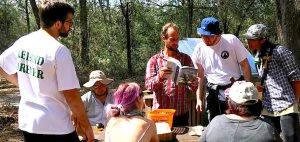
Orlando Mushroom Group in the field.
As you can tell by the schedule above Orlando Mushroom Group will have its spring mushroom hunt with Joshua Buchanan May 20th at the Lower Wekiva River Preserve State Park. That is on State Road 46 (west of Sanford.) Because of road construction the exact place where we will meet will be announced soon. Time: 9 a.m. Fee: $10 per adult. Rain or shine (except hurricanes.) Dress for bugs, walking and know rattle snakes are common in the area. We will be finding and identifying various local mushrooms. The location has produce a wide array of both edible and non-edible mushrooms from chanterelles to Lactifluus to Boletes. You can RSVP here and or email GreenDeane@gmail.com
 Donations to upgrade EatTheWeeds.com and fund a book are going well. Thank you to all who have contributed to either via the Go Fund Me link, the PayPal donation link or by writing to Green Deane POB 941793 Maitland FL, 32794. Recent upgrades have been paid now the Forum needs work and several function problems need to be fixed specifically the search and categories. A new server also being considered. The other issue is finding an indexing program or function for a real book. Writing programs used to do it automatically if you designated a term for indexing. Now that most books are ebooks most writing programs do not provide and indexing function.
Donations to upgrade EatTheWeeds.com and fund a book are going well. Thank you to all who have contributed to either via the Go Fund Me link, the PayPal donation link or by writing to Green Deane POB 941793 Maitland FL, 32794. Recent upgrades have been paid now the Forum needs work and several function problems need to be fixed specifically the search and categories. A new server also being considered. The other issue is finding an indexing program or function for a real book. Writing programs used to do it automatically if you designated a term for indexing. Now that most books are ebooks most writing programs do not provide and indexing function.
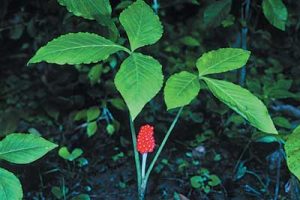
Jack in the Pulpit. Photo byGreen Deane
Jack In The Pulpit are strange plants. They’re listed amongst the edible species but they are barely edible. They also readily change sex. After reproducing they become males and do nothing but hang out on the forest floor drinking sunlight and making starch. When enough energy is collected for reproduction they become females… It’s not a species that does much dating. They are usually found in damp areas with dappled sunlight. To read more about Jacks you can go here.
This is weekly issue 302.
If you would like to donate to Eat The Weeds please click here.


A while back, I barely pricked the skin of a red ripe end-of-season Jack-in-the-Pulpit berry with my front tooth. It was sickeningly sweet like something out of a fairy tale. My tongue went numb, and I really learned the first rule of foraging. I am going to stay away from eating any part of them now.
I was able to collect many Morning glory seeds from last year generation I nursed here in my back garden in Kafouri – Khartoum North . The origional seeds I obtained from Aazon . I like the pink blossoms . In ” Butana ” area which covers very fertile soil between Blue Nile and White Nile, cattle and camel shepards use the dry plant as fodder specially after the rainy season . I hope I can plant last year seeds before getting useless .